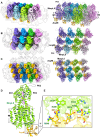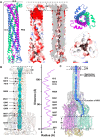Structures of MmpL complexes reveal the assembly and mechanism of this family of transporters
- PMID: 40802754
- PMCID: PMC12346298
- DOI: 10.1126/sciadv.adx1129
Structures of MmpL complexes reveal the assembly and mechanism of this family of transporters
Abstract
We coexpressed the mycobacterial membrane protein large 5 (MmpL5) transporter and MmpS5 adaptor proteins in Mycobacterium smegmatis and defined their structures from detergent-solubilized crude membranes. We observed that MmpL5 presents as a monomer in complex with the cytosolic meromycolate extension acyl carrier protein M (AcpM), where these AcpM-MmpL5 complexes generate regular two-dimensional arrays. We also provide structural information to show that M. smegmatis MmpL5 assembles as a trimer that interacts with MmpS5 and AcpM to form the tripartite complex AcpM-MmpL5-MmpS5 that spans both the inner and outer membranes of the mycobacterium. In addition, we found that MmpL5 and AcpM are able to form the trimeric AcpM-MmpL5 complex. The structural data reveal that the full-length MmpL5 trimer is capable of spanning the entire mycobacterial cell envelope to transport substrates. However, this assembly requires the presence of MmpS5 to stabilize secondary structural features of the MmpL5 periplasmic subdomains.
Figures






Update of
-
Structures of MmpL complexes reveal the assembly and mechanism of this family of transporters.bioRxiv [Preprint]. 2025 Jun 22:2025.06.22.660944. doi: 10.1101/2025.06.22.660944. bioRxiv. 2025. Update in: Sci Adv. 2025 Aug 15;11(33):eadx1129. doi: 10.1126/sciadv.adx1129. PMID: 40667201 Free PMC article. Updated. Preprint.
Similar articles
-
Structures of MmpL complexes reveal the assembly and mechanism of this family of transporters.bioRxiv [Preprint]. 2025 Jun 22:2025.06.22.660944. doi: 10.1101/2025.06.22.660944. bioRxiv. 2025. Update in: Sci Adv. 2025 Aug 15;11(33):eadx1129. doi: 10.1126/sciadv.adx1129. PMID: 40667201 Free PMC article. Updated. Preprint.
-
Cryo-EM structure of the Mycobacterium smegmatis MmpL5-AcpM complex.mBio. 2024 Dec 11;15(12):e0303524. doi: 10.1128/mbio.03035-24. Epub 2024 Oct 31. mBio. 2024. PMID: 39480109 Free PMC article.
-
Structure and assembly of the MmpL5/MmpS5 efflux transporter from Mycobacterium tuberculosis.Nat Commun. 2025 May 29;16(1):4976. doi: 10.1038/s41467-025-60365-5. Nat Commun. 2025. PMID: 40442140 Free PMC article.
-
Antidepressants for pain management in adults with chronic pain: a network meta-analysis.Health Technol Assess. 2024 Oct;28(62):1-155. doi: 10.3310/MKRT2948. Health Technol Assess. 2024. PMID: 39367772 Free PMC article.
-
Survivor, family and professional experiences of psychosocial interventions for sexual abuse and violence: a qualitative evidence synthesis.Cochrane Database Syst Rev. 2022 Oct 4;10(10):CD013648. doi: 10.1002/14651858.CD013648.pub2. Cochrane Database Syst Rev. 2022. PMID: 36194890 Free PMC article.
References
-
- World Health Oganization, Global Tuberculosis Report 2024 (World Health Oganization, 2024).
-
- Wallis R. S., Maeurer M., Mwaba P., Chakaya J., Rustomjee R., Migliori G. B., Marais B., Schito M., Churchyard G., Swaminathan S., Hoelscher M., Zumla A., Tuberculosis—Advances in development of new drugs, treatment regimens, host-directed therapies, and biomarkers. Lancet Infect. Dis. 16, e34–e46 (2016). - PubMed
-
- World Health Oganization, Global tuberculosis report 2017 (World Health Oganization, 2017).
-
- Brennan P. J., Nikaido H., The envelope of mycobacteria. Annu. Rev. Biochem. 64, 29–63 (1995). - PubMed
-
- Cole S. T., Brosch R., Parkhill J., Garnier T., Churcher C., Harris D., Gordon S. V., Eiglmeier K., Gas S., Barry C. E. III, Tekaia F., Badcock K., Basham D., Brown D., Chillingworth T., Connor R., Davies R., Devlin K., Feltwell T., Gentles S., Hamlin N., Holroyd S., Hornsby T., Jagels K., Krogh A., McLean J., Moule S., Murphy L., Oliver K., Osborne J., Quail M. A., Rajandream M. A., Rogers J., Rutter S., Seeger K., Skelton J., Squares R., Squares S., Sulston J. E., Taylor K., Whitehead S., Barrell B. G., Deciphering the biology of Mycobacterium tuberculosis from the complete genome sequence. Nature 393, 537–544 (1998). - PubMed
MeSH terms
Substances
Grants and funding
LinkOut - more resources
Full Text Sources

